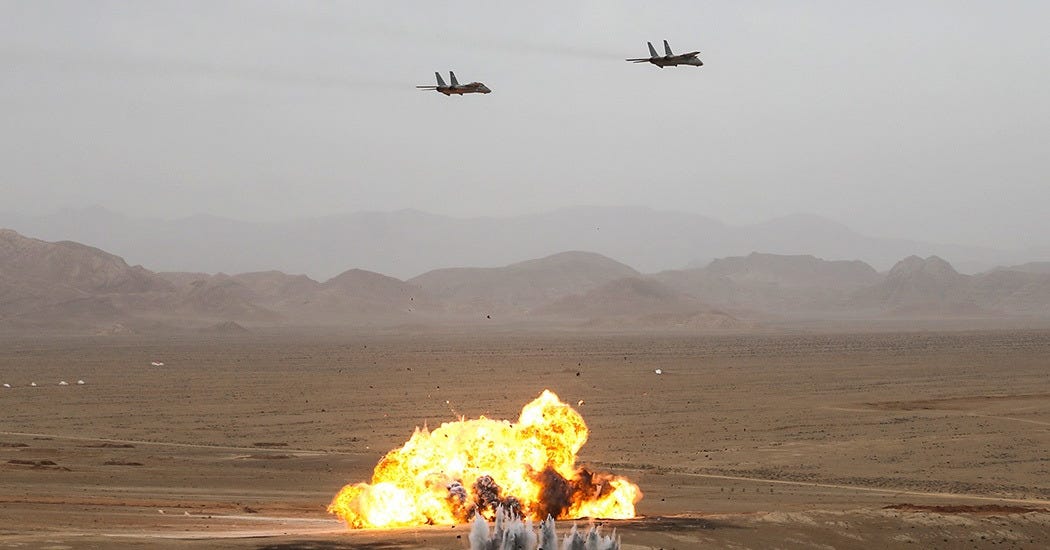In the 1980s, Iran Outfitted F-14s as Heavy Bombers
One Iranian Tomcat lobbed a 7,000-pound munition
by JASSEM AL SALAMI
Nearly 30 years, ago, the Iranian air force modified its U.S.-built Grumman F-14 Tomcat fighters to carry air-to-ground ordnance—including, in one spectacular case, a massive, 3.5-ton bomb.
Iran’s bitter enemy Iraq actually inspired the idea of outfitting the twin-engine, swing-wing F-14s as bombers. Iran and Iraq fought a bloody war between 1980 and 1988.
Iraq’s most notorious interceptor and recon jets were also its most prolific bombers. Baghdad’s Soviet-supplied Mikoyan MiG-25 Foxbats could carry free-fall bombs and still reach Mach 2.5 at 60,000 feet.
Using the advantage of speed and altitude, a MiG-25RB could release its bombs 31 miles from the target and accelerate to Mach 3 for the dash back to base.
The Iranians were desperate to stop the Foxbats. They prepared ambushes along probable approach routes with Chinese HQ-7 and American-made I-Hawk surface-to-air missiles. They even examined Syrian MiG-25s hoping for insight into possible defenses.
But despite all their efforts, the Iranians never could counter the Iraqi MiG-25 bombers. Iran did shoot down a few MiG-25s—but only through sheer luck.
In 1983, the Islamic Republic of Iran Air Force decided that if it couldn’t stop the Foxbats, it should at least have an equivalent weapon. Iran’s McDonnell Douglas F-4 Phantom fighter-bombers could carry a heavy load at high altitude, but only at reduced speed.
And the old Phantoms lacked sophisticated bomb-aiming computers, rendering long-range drops inaccurate.
Iran had acquired 79 of the powerful F-14s before the 1979 Islamic revolution that resulted in Tehran and Washington severing ties. The Tomcat has a central under-fuselage canal that reduces the drag effect from large bomb loads.
The F-14 also has a much more powerful computer than the F-4 does, meaning Tehran’s engineers could modify the Tomcats with automatic bomb-release algorithms. What the Iranian F-14s lacked was bomb racks.
The IRIAF’s self-sufficiency office claimed for years that the program to add bombs to F-14s was a fully domestic project. Now we know that’s not true. During a recent air show at 8th Air Base in Isfahan, the air force displayed an F-14 with a dozen free-fall bombs hanging in its central canal.
The bomb racks were not Iranian, but American BRU-34s and BRU-42s bearing U.S. Air Force markings.
The U.S. Air Force first used such bomb racks during mid-’80s, around the same time Iran started its Tomcat-bomber project. Because there were so few of the racks in existence, it’s highly improbable that the Iranians got them through the black market and without the knowledge of the U.S. Air Force.
At the time, Washington was trying to repair its relations with Iran through secretive arms deliveries. In an affair later dubbed “Irangate,” the U.S. delivered stockpiles of artillery shells and anti-tank weapons to Iran.
The latest information suggests that during the Irangate affair, Washington also delivered to Tehran the equipment necessary to convert F-14s to bombers. This development implies direct military contact between Iran and the U.S., through which American officials understood the immediate strategic needs of the Iranian air force.
According to official records, the first F-14 bombing run took place in 1985. The pilot was one of the IRIAF’s best—Gen. S. Rostami, the first Iranian to target a MiG-25.
To maintain project secrecy, the first flight took place from 5th Air Base, even though the Tomcats squadrons were located at the 1st, 2nd, 6th, 7th and 8th Air Bases. The target was the field headquarters of an Iraqi division near the front line.
The mission went according to plan, but the bombs fell wide and the target sustained only minor damage.
The next step was to develop a heavyweight bomb. The IRIAF prepared a whopping 7,000-pound munition—one of the biggest air-to-ground munitions ever deployed. This time, Gen. Abbas Babaei, the IRIAF’s commander in chief, traveled to a front-line observation post to see the effect for himself.
The F-14 pilot signaled the bomb release. The estimated time on target passed … and nothing happened. As Babaei was getting ready to return to his jeep, a powerful blast shook the ground—admittedly far from the target, but with an obvious psychological effect.
Toward the end of the war, the Iranian air force struggled to keep its fighter fleet operational. Relations with the U.S. again soured and the IRIAF couldn’t acquire spare parts. Tehran tasked its ballistic-missile forces to take over long-range ground strikes, while the F-14s returned to air-combat duties.
Read more:
Secretive U.S. Navy F-14s Covered Commandos in Iraq in 2003
Early in the morning on March 19, 2003, U.S. Special Operations Forces infiltrated western Iraq to neutralize strategic radar and command installations. It was one of the first attacks of the American-led invasion—and it played out under the watchful gaze of a secretive detachment of aging but still very capable U.S.…







